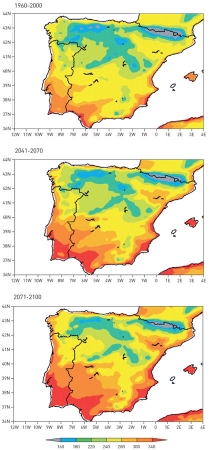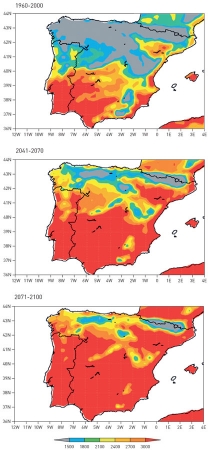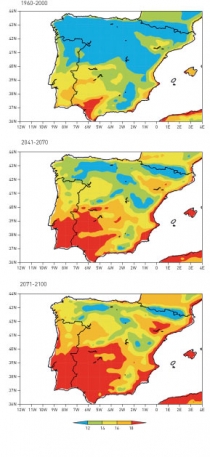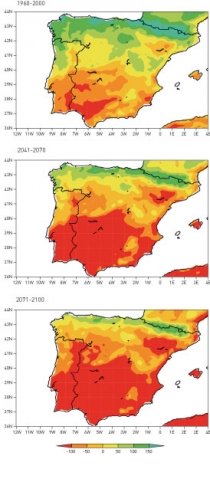Viticultural Regions of the Iberian Peninsula in the Light of Climate Change
The current regional and global climate models indicate an intensification of viticultural conditions for the next century in terms of temperature and rainfall, which one should begin taking into account now.
Viticulture is an activity of primary economic, social and environmental importance on the Iberian Peninsula and hence must be sustained. One of the chief factors influencing the production of quality wine grapes is that of climate, and possible climate change presents yet one more challenge for present day viticulture. In fact, historical climatic data reveal a significant increase in temperature of 0.6°C since the 19th century. This phenomenon affects Southern Europe in particular, where it is conjectured that in the coming decades, particularly during summer, there will be a rise in atmospheric temperature of between 2.2°C and 5.1°C, and a rainfall deficit ranging from 4% to 27%. One telling example of conditions comes from the Douro wine growing region where one of its most important varieties, the Aragonez (syn. Tempranillo, Tinta Roriz) experienced a temperature increase for the months April‑October from its traditional optimum of 16°C‑19°C to its current 17°C‑20°C. According to studies available, in terms of the climate scenario A1B, an increase in temperature of 2°C during the grapevine vegetative cycle would mean that the necessary climatic conditions would no longer exist for the variety in a significant portion of the area under cultivation, particularly in the upper Douro.
With respect to the current greenhouse effect, if one considers the CO2 emission levels published by the Intergovernmental Panel on Climate Change (IPCC), together with the anticipated total population growth and economic development, and the balance of all (fossil and non fossil) energy sources in the 21st century, it is predicted that CO2 emissions are set to increase from 367 ppm (2000) to 703 ppm. There are climate scenarios, such as B1, for example, which when compared to A1B, appear relatively positive, because each of them has a lower projected CO2 concentration, or A2, which delivers a far more pessimistic picture. These climate changes have an effect on the growth and development of the grapevine and consequently compromise the quality of the wine produced. Moreover, extreme weather events (hail, storms, flooding) lead to severe losses in production or quality. The acceleration of the phenological cycle, with corresponding earlier harvests, triggers new or more severe occurrences of known pests and fungal diseases, which can result in greater yield inconsistency and greater variation in the quality of the wine.
Bioclimatic Indices
With regard to the correlation between the climatic requirements of the grapevine and its vegetative cycle, various bioclimatic indices could be developed. These indices constitute a crucial element in determining whether viticultural regions are suitable for the planting and cultivation of a particular grapevine variety, from a cost recovery perspective. One of the first of these indices was Winkler’s index, which is the sum of all degree days from 1 April to 31 October (where one degree day equals the average daily temperature less 10°C). This index was initially created for Californian conditions, but soon found applicability in other regions as well, particularly in Europe. For more precise detail the reader is referred to Nuno Magalhães’s book in Portuguese entitled Tratado de Viticultura [Treatise on Viticulture]. The Cool Night Index (CI) is a thermal indicator of night time temperature conditions during maturation (September). The variation in temperature at the end of the maturation period contributes significantly to improving the quality of the wine by, for example promoting the synthesis of anthocyanins. The Huglin index of heliothermal aptitude has the advantage that it also takes into consideration the length of daylight hours together with ambient temperature conditions, the former being one more decisive factor influencing the quality of the grape. It is calculated from the period April to September using a formula which puts more weight on the daily maximum temperature whilst still taking the daily mean temperature into account. It differentiates between six viticultural climate zones from very cold (IH > 1500) to very hot (IH > 3000).
High IH values are conducive to planting varieties with late maturation, whilst lower values indicate suitability for varieties which mature early. A value of 1400 is considered the minimum value suitable for viticulture. The Dryness Index builds on the Riou’s humidity balance and considers the water retention capacity of the soil at the start of the growth period (estimated at 200 mm), the evaporation potential, and precipitation. This index is a complex indicator which takes into account the various factors which contribute to dryness.
Viticulture and regional macroclimate in the light of climate change
An attempt will be made below to evaluate the specific impact of climate change on viticulture on the Iberian Peninsula, for which the following bioclimatic indices will be used:
1) Growing degree days per year (PFA, or ETI (the sum of days with a mean daily temperature above 10° C
2) The Huglin Index (IH),
3) The Cool Night Index (IF)
4) The Dryness Index (IS).
All indices were calculated for the following periods: the recent past (1960‑2000), the near future (2041‑ 2070), and the distant future (2071‑2100). For this the daily precipitation and daily maximum and minimum temperatures based on the regional COSMO‑CLM calculation model will be used. This model, developed in Germany, corresponds to a spatial resolution of 0.165° latitude and longitude (18 km raster).
The results of the mean deviation of the three sample periods are shown in Fig. 178. As a rule, one describes an area as being suitable for viticulture if the PFA is greater than 182 days. This includes practically the entire Iberian Peninsula, except for the mountainous regions of the Pyrenees. The period 2071‑2100 shows an increase in the PFA value for the whole of the Iberian Peninsula, and predicts the emergence of some new potential viticultural regions in the North (areas at high altitude). In summary, there is the possibility of extending viticulture to new regions in Northern Spain which have previously been too cold; conversely, in Southern Portugal dormancy problems could occur, with negative consequences for wine quality.
The average pattern in respect of the IH corresponds in general to the PFA results, although it also provides a more precise demarcation of viticultural zones (Fig. 178). This index generally shows high values, which stands viticulture in this part of Southern Europe in good stead, and is of consequence to high profile viticultural regions such as the Douro Valley, the Alentejo, and Andalusia and La Mancha.
Despite the striking coincidence of the IH zones with viticultural regions, only limited conclusions can be drawn in relation to the climate model, because difficulties are encountered in collecting precise climatic data, and thereby assigning viticultural suitability to specific regions. In the future one will have to assume that certain regions will change to be classed as warm zones (Fig. 178). Climate change, as predicted here, will be a considerable challenge to viticulture and could even become a real threat to the trade, if appropriate measures are not taken in good time. The mean IF deviation in September in the North of the Iberian Peninsula guarantees a very cold rating (IF ≤ 12°C) and cool nights (12°C < IF ≤ 14°C), which indicates that extremely warm nights in this zone at the end of the maturation period are a rare occurrence (Fig. 179). This means that in the future lowlying areas will experience a significant increase in temperature, which could affect quality negatively, as mentioned above. For the period referred to here as the recent past, according to the Dryness Index (IS), the South of the Iberian Peninsula returned a result showing a climate change from “moderately dry” to “particularly dry” (the two lower intervals of the scale, Fig. 179), whereas in the North‑East and at higher elevations, zones are indicated as “semi‑wet” and “wet” (the three upper intervals of the scale, Fig. 170). As a result, the future will bring an increase in viticultural suitability especially for red varieties. Here, the index value of “moderately dry” (50 ≤ IS < 100 mm) is considered suitable for quality wines. However, the “particularly dry” (DI > 100 mm) conditions produce drought stress in the grapevine, which can lead to unbalanced wines with undesirable characteristics (cabbage tone, low acidity, excessive alcohol). Supplementary irrigation is essential in these areas, in spite of the general water shortage, especially in high mountain areas. In the A1B zone, which includes most of Iberia, increased dryness is predicted; this is particularly pronounced in the Portuguese interior. Lastly, some regions will prove to be too hot and dry to produce quality wine.
Conclusion
Despite uncertainties inherent in a long‑term climate forecast, assumptions can be made concerning fundamental changes in the viticultural landscape of the future based on the four climatic indices studied. Whilst new vineyard regions (above 600 m) will be created, with better conditions than today, in the North‑East and along the coast, this is far outweighed by the detrimental factors which will be suffered in terms of the quality and quantity of wine attributable to drought and extreme heat, particularly in the South of the Peninsula. The above in no way negates the fact that there are also existing viticultural regions in Portugal and Spain which stand on the threshold of even better production conditions for top wines. In order to be able maintain the overall level of quality achieved thus far, climate change requires not only decisive measures to be taken in the short term (such as sun protection and irrigation), but long‑term strategies (rootstock selection, and relocation of vineyards to higher elevations) to be formulated as well. It should be mentioned in closing that this study dealt solely with the input of climatic data, and did not take into account soil type, a factor which also has to be considered when deciding on viticultural suitability.





